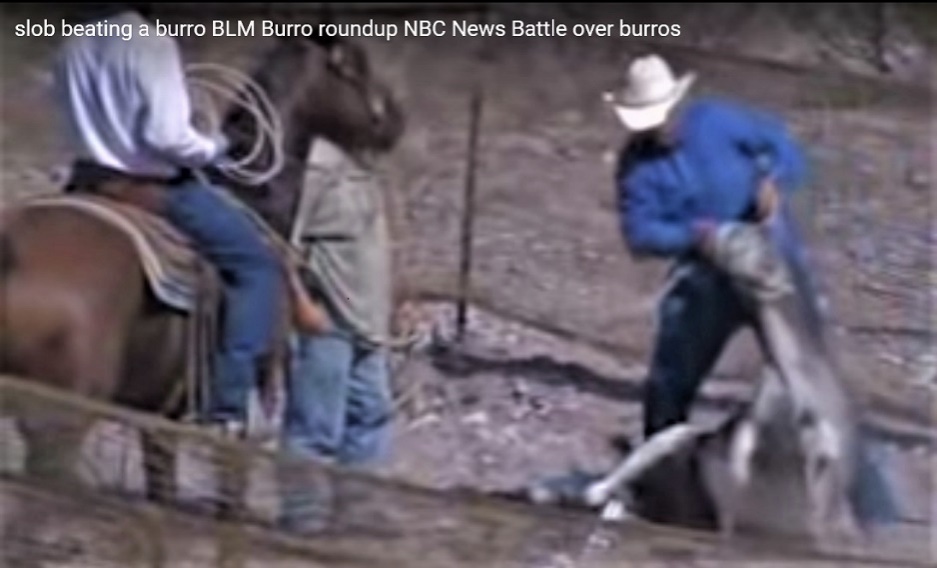Wild Horses: Analysis of The Issues and a Novel Science-supported Solution

Quoting the author of the article below, “The current American wild horse management paradigm fails economically and ecologically. Despite decades of activity, the wild horse advocacy has had virtually no meaningful effect on the plight of American wild horses. And, unfortunately, they have offered no plan that is genetically, ecologically or economically sustainable that allows wild horses to truly be “wild and free” as is intended by the 1971 Free Roaming Wild Burro And Horse Protection Act.
The Wild Horse Fire Brigade can provide a naturally sustainable, cost-effective solution that benefits a majority of all the stakeholders as well as the wild horses (and burros) and the wilderness ecosystems that can be assigned to them.”
NOTE: this article is written by William E. Simpson II. Images are property of William E. Simpson II and were provided by him and used here with his permission.
Is there a holistic solution for the plight of American wild horses that is both economically and ecologically sensible, and acceptable to a majority of stakeholders?
A recent article at Reason, titled “Predictably, Wild Horses Are Still Suffering Due to Federal Slaughter Ban” stated that, “Turns out that basing animal rights policy on the strong feelings of animal rights activists is not working out so well for the animals themselves”.
While the title of the article seems to imply that America’s wild horses would be better off if there was no ban on slaughter, the statement about the failure of emotionally driven efforts of activists is debatably correct.
The economic argument against slaughter is straight forward and compelling: each wild horse in worth $72,000 in a wildfire abatement role. And that case is clearly made in a two-part feature series in the Medford (Ore.) Mail Tribune titled: “What is the value of a wild horse”: Part-1: and Part-2.
With the economic argument for wild horses settled we must still address the arguments around the obsolete and misguided policies driving the mismanagement of American wild horses.
After decades of emotionally-driven efforts and tens of millions of donation dollars spent, America’s wild horses are arguably worse-off today than anytime in the past 30 years.
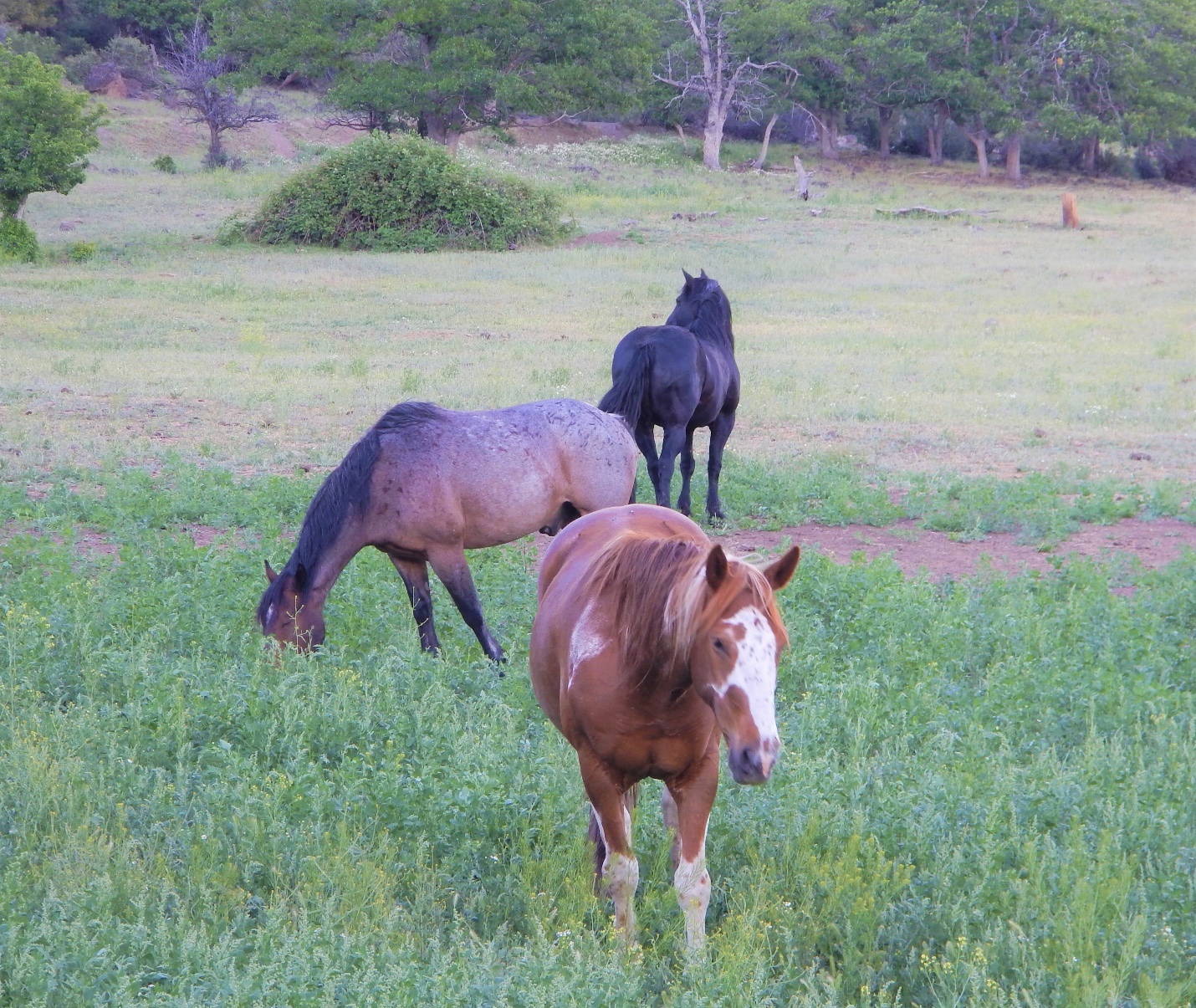
A small band of native species American wild horses in a remote wilderness area. Photo courtesy William E. Simpson II
It’s is truly sad to see the current plight of America’s wild horses and burros today, which have suffered setback after setback since they were protected in 1971 by the Wild Burro & Horse Protection Act.
In the preamble to the Act, Congress states:
“Congress finds and declares that wild free-roaming horses and burros are living symbols of the historic and pioneer spirit of the West; that they contribute to the diversity of life forms within the Nation and enrich the lives of the American people; and that these horses and burros are fast disappearing from the American scene. It is the policy of Congress that wild free-roaming horses and burros shall be protected from capture, branding, harassment, or death; and to accomplish this they are to be considered in the area where presently found, as an integral part of the natural system of the public lands.”
As we examine the history of wild horse management since the Act was codified by Congress, we clearly find that there has been government malfeasance in the caring for wild horses and burros under the Act.
Some of the most important intentions of the Act were stated with these words: “wild free-roaming horses and burros shall be protected from capture, branding, harassment, or death”.
It’s shocking to learn that people working for and at the Bureau of Land Management (BLM) and United States Forest Service (USFS) have either condoned by inaction, or participated in deeds that are diametrically opposed to the forementioned law, and have allowed or engaged in the “capture, branding, harassment and death” of wild horses and burros. The evidence is staggeringly clear and would convict anyone of such violations in any just court of law.
During roundups, wild horses and burros are driven beyond their physical abilities. In many cases, some die from stress during or after the roundups. Foals literally run their hooves off—and some can’t keep up and are lost, left behind for predators. Pregnant mares abort their unborn. Some die from shock out on the range. And most of these atrocities are concealed from the public.
Some atrocities are not concealed, though. Here are videos documenting a BLM contractor helicopter ramming a fleeing burro and a BLM contractor beating and punching a burro: VIDEO EVIDENCE The contractor was never prosecuted.
https://www.youtube.com/watch?v=9zVUHwkPwW4
This disturbing video is just one of many available. It’s no wonder that many people become emotionally driven to stop what may now be widespread abuse in wild horse and burro management.
Clearly, today there are diametrically opposed forces that have clashed in what some folks perceive as a “war“, which has been—and continues to be—composed of many battles. Individual advocates and non-profit groups have faced-off against the government and each other at times. For instance, there are heated divides between pro-PZP (Porcine Zona Pellucida) and anti-PZP birth control measure for wild horses.
In another example, wild horse and burro advocates are aggressively opposing livestock industry advocates, who also enjoy widespread support and would like more cheap grazing rights on public lands. In the business world of business, who could blame them? All businesses strive and compete to reduce the cost of goods produced, which in this instance is meat for the markets.
The competition for all land uses, both public and private has increased due to consumerism, and will continue in years to come. So, the future for wild horses and burros is under pressure, regardless of the 1971 Act.
The government, on the other hand, has to answer (to some extent) to the people for tax dollar use , while also balancing demands on public resources and industry needs. It’s not an easy task by any means, even with a perfect system, which we do not have.
Then there is the competition for donation-dollars by non-profit organizations regarding the wild horse and burro dilemma and controversy. There are only so many donation-dollars available, and non-profits compete, at times quite aggressively, for that money.
This competition alone creates divides in the advocacy, where each organization tries to create and maintain a higher “status” in the eyes of potential and existing donors. When one advocacy group succeeds at fundraising, it is sometimes done at the expense of other groups or people who are seen as possibly diverting, diluting or eliminating the need for funding.
And in the realm of wild equine advocacy, an important distinction must be made. There is a difference between non-profit activists, whose funds are not used to directly rescue and provide long-term sanctuary for wild horses, and sanctuaries that have fixed costs for the long-term care for rescued wild horses and burros.
Some non-profit activists have a business model that includes keeping a token number of wild horses off the range in so-called sanctuaries, which are arguably window dressing for media opportunities and fundraising purposes. Practically speaking, when thousands of wild horses are being rounded-up and placed at risk of slaughter and just 1–2 percent are “rescued” that isn’t a game changer for wild horses. Our wild horses are wildlife, and belong unfettered, wild and free on American wilderness landscapes.
Non-profit conflict of interest
Thousands of jobs have evolved from and around the myriad of non-profits addressing the wild horse and burro controversy, either directly or indirectly.
One question that may be weighing on some of these non-profits is: What happens if a holistic management solution for all of the wild horses and burros was enacted tomorrow?
And this primary question engenders many more: What happens to these non-profits and all of the jobs that are based solely on the continuing plight of wild horses and burros? If a holistic management solution was implemented tomorrow, do all these non-profit organizations happily declare the “war is over” and go home like soldiers from a war or what? If so, how do the people working at these numerous organizations pay their bills if they lose their employment, noble or not?
Making matters even more complicated, some non-profit organizations play both sides of the street, arguably to maintain cash-flow for their very survival.
Case in point, the non-profit wild horse organization Return To Freedom, which might be more aptly named “return to confinement’…
According to an article by Debbie Coffey, V ice President & Director of Wild Horse Affairs at the Wild Horse Freedom Federation:
“Sadly, as many of you know, Return to Freedom, ASPCA, HSUS, Humane Society Legislative Fund, and the little known American Mustang Foundation (formed by lobbyists in 2016), threw their hats in the ring with many pro-horse slaughter livestock industry organizations, including the National Cattlemen’s Association, on a proposal titled, “The Path Forward for Management of BLM’s Wild Horses & Burros” that is really a road to extinction for America’s wild horses and burros on public lands.”
And it seems that as the saying goes, a leopard never changes its spots. There is a public record showing that Return To Freedom has been paid ($440,000) to roundup American wild horses, as evidenced in the online document below:
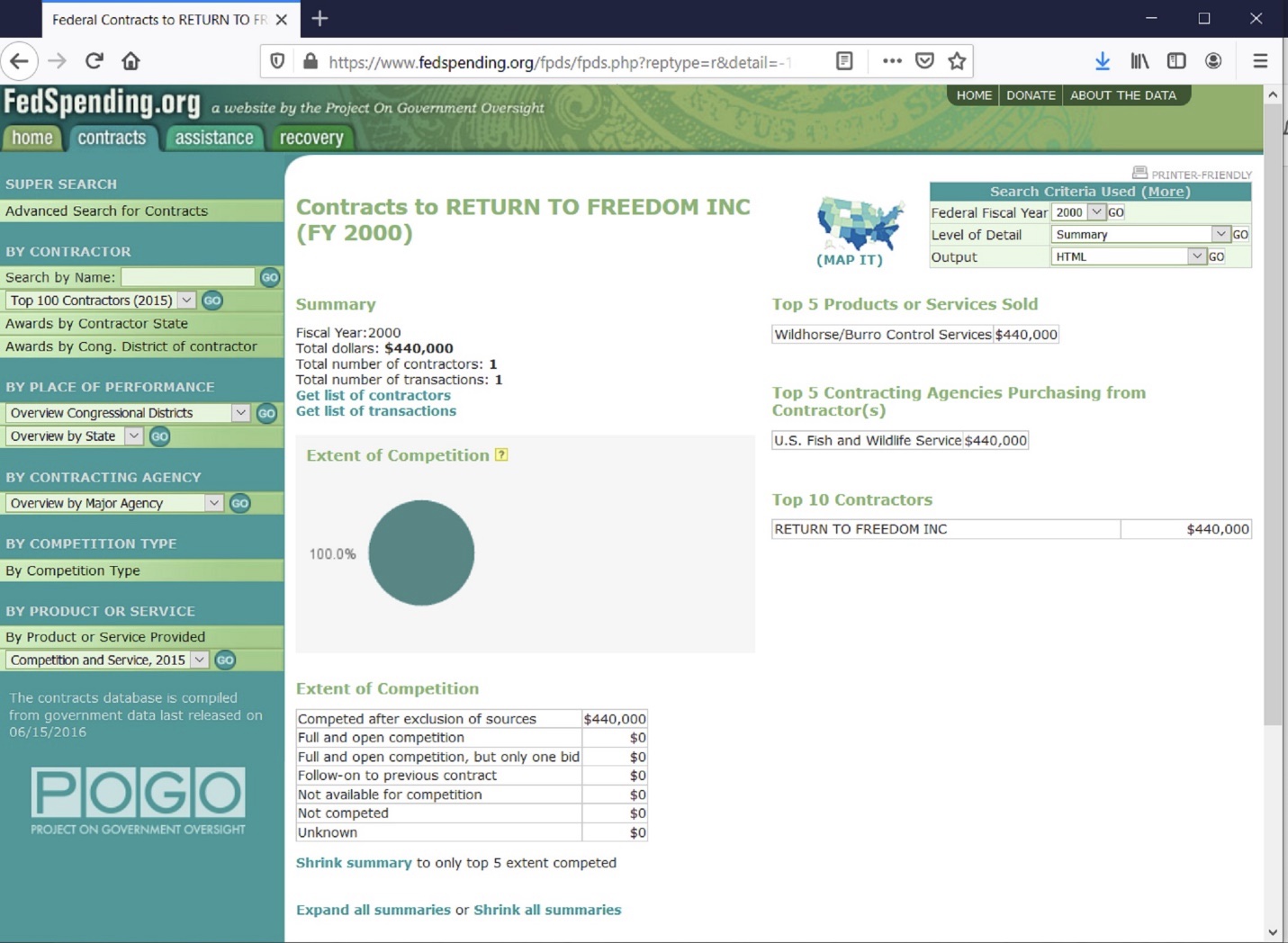
Even some ranchers who once raised cattle are cashing-in on the plight of American wild horses and are now making a very good living off the BLM by warehousing wild horses off-range. The tax payers price tag? $100 million annually.
By paying ranchers more than $100 million annually to house wild horses off-range, the BLM is seriously wasting American tax dollars (The Drummond family of Oklahoma has already been paid $24 million by the BLM.).
What happens to these profiteers if a holistic management solution were enacted tomorrow? Could they even go back to raising beef from scratch or without this supplemental income? Maybe not.
Ecosystems (flora and fauna) are devastated in wild horse roundups:
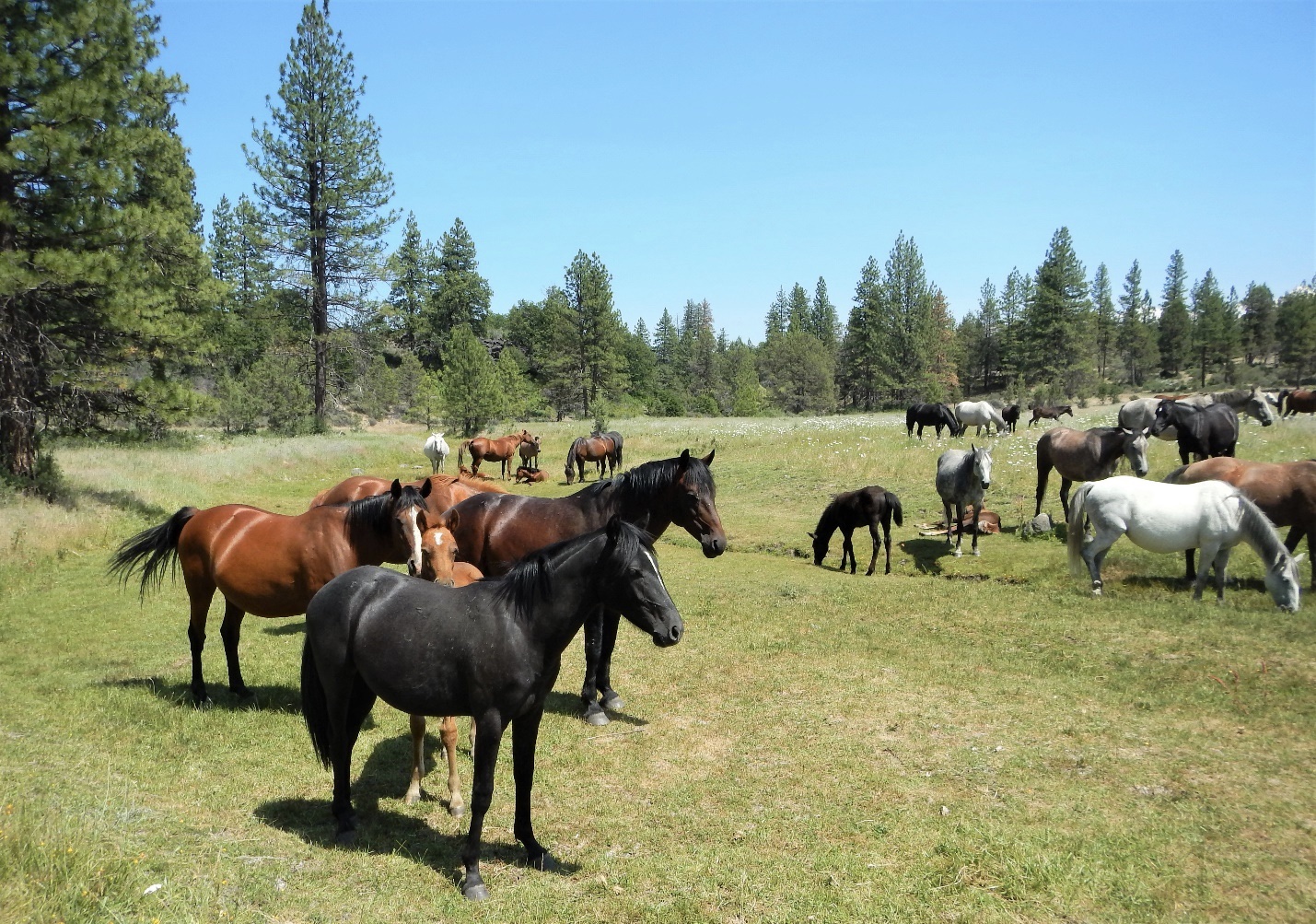
This herd of native wild horses in an alpine wilderness area on the Oregon-California border have lived harmoniously and symbiotically within the ecosystem for hundreds of years. The area nevertheless remains pristine. Photo courtesy William E. Simpson II
Roundups that use helicopters and other vehicles, force wild horses to flee for their lives randomly which is abnormal behavioral in response to motorized roundups across the landscape. I n the process of their desperately fleeing, they inadvertently trample threatened and endangered species of flora and fauna, as do other fleeing wildlife such as deer, elk, etc.
The trampling damage caused by the BLM & USFS roundups, affects the nests of ground birds such as sage grouse and quail crushing eggs and sometime the birds themselves. The horses’ and wildlife’s thundering hooves also crush small mammals and reptiles as they try to escape from the helicopters (and motorized vehicles) that disrupt the normal tranquility of the ecosystems in the midst of a monetary–biased War on Nature
These wide-scale roundups by the BLM and USFS are coupled with the systematic implementation of a combination of methods that are arguably designed to lead to genetic erosion and loss of genetic diversity, leading to the ultimate extinction of free-roaming native species American wild horses…
The methods currently being used by the BLM, USFS and their cronies, include these:
1) Reducing breeding populations so low (less than 200 breeding adults in a herd) as to induce in-breeding and loss of genetic vigor.
Just one of many examples: Shane Jefferies, Forest Supervisor for the Ochoco National Forest (USFS) in Oregon claimed that the “appropriate management level'” (AML) for native-species American wild horses in the Big Summit Wild Horse Territory of the Ochoco National Forest is about “12 – 57 wild horses”.
“The Bureau of Land Management (BLM) recommends that wild horse herds should contain a minimum of 150–200 animals.” (BLM Handbook at 22).
The forementioned BLM herd management information was confirmed in a comprehensive report (page 28) presented to the National Academy of Sciences Committee to “Review the Management of Wild Horses and Burros,” by Animal Welfare Institute.
So, as we see, the USFS (and the BLM) are managing wild horses in conflict with their own guidelines. In fact, in over half of the Herd Management Areas (HMAs), wild horses are intentionally being managed with populations of 50 or fewer wild horses, thus assuring inbreeding and ultimately genetic failure. Such management is inconsistent with the 1971 Act; and,
2) Castration of stallions, which results in the loss of genetic diversity. (At the moment, we don’t know which alleles are responsible for the resistance that wild horses have to Chronic Wasting Disease., Castrating stallions also interferes with evolved evolutionary competition for breeding rights (survival of the fittest); and,
3) Chemical interventions (PZP & GonaCon) which interrupt critical social structures in family bands. For example, matriarch mares lose status and their intuitive knowledge for survival is lost to family bands. In other cases, some mares become infertile. Darting wild horses with chemical contraceptives, as some of wild horse organizations lobbying legislators want to do, is not ecologically correct and it disintermediates evolutionary processes. According to a published study, darting wild horses using compressed-gas firearms causes trauma to horses and can lead to bleeding, hematoma and even death. This press release discusses this point in detail: https://rtfitchauthor.com/2021/06/17/can-wild-horse-non-profit-advocates-save-americas-wild-horses-by-drugging-them/
4) Wild horses are being shot to death by people now emboldened by what seems to be an “open season” on wild horses by the BLM and USFS. This public disregard for the lives of wild horses can likely be traced to the public resulting from what the public sees as a total disregard for the value of these sentient beings by these government agencies.
5) The BLM has audaciously proposed using an outdated procedure known as “ovariectomy via colpotomy.” In this procedure, a metal rod-like tool is blindly inserted through a vaginal incision in order to sever and remove the ovaries of wild mares while they remain conscious.
The government agencies (DOI, BLM, USDA, USFS), which are arguably influenced by money and politics around public land livestock grazing, are devastating the remaining populations of the relatively few (based on genetic diversity) remaining American wild horses….
The BLM is still engaged in an ongoing campaign of “willful ignorance and misinformation'” by continuing to propagate manifestly false statements, including but not limited to:
“Wild horses have no natural predators…” This is a false statement promoted by the BLM that is and now widely repeated.
This false and misleading statement appears on Page 1, Executive Summary, paragraph 5 in the so-called management plan presented to Congress, Report To Congress – Management Options For A Sustainable Wild Horse And Burro Program.
Only a corrupted agency would manage a wildlife resource with a fabrication as the core premise for radical arbitrary population reductions.
It’s a well-known scientific and common-knowledge fact that: All north American apex predators including mountain lions, bears, wolves and coyotes evolved as natural predators of wild horses and burros
We need to restore ecological balance and the trophic cascades in the remaining remote wilderness areas where that is still possible. In many remote wilderness ecosystems e the American wild horse is a critical keystone-species large-herbivore.
In business, when any solution is contemplated, the process involves analyzing the current state of the art, identifying and critically reviewing the weaknesses and places where improvement can be made, and finally, offering a potentially better solution.
History shows anyone who will look that in the 46 years since the Act’s passage to protect the wild horses and burros in America, the advocacy, as it is, has not achieved what is needed. We are missing a final holistic solution acceptable to a majority of all stakeholders that works for the livestock industry, and also saves wild horses and burros from mismanagement and the resulting atrocities witnessed over the few past decades.
It seems with that documented history leading to where we are today with wild horses in America facing slaughter, advocates would embrace any solution that offered hope for the horses and burros? Shockingly and sadly, there are some non-profit activists and their supporters who are more about the fight and process than a final positive result.
Solution to Save American Wild Horses and Provide Adequate Livestock Grazing
A proven, natural method for managing America’s wild horses that is cash-positive for taxpayers exists.
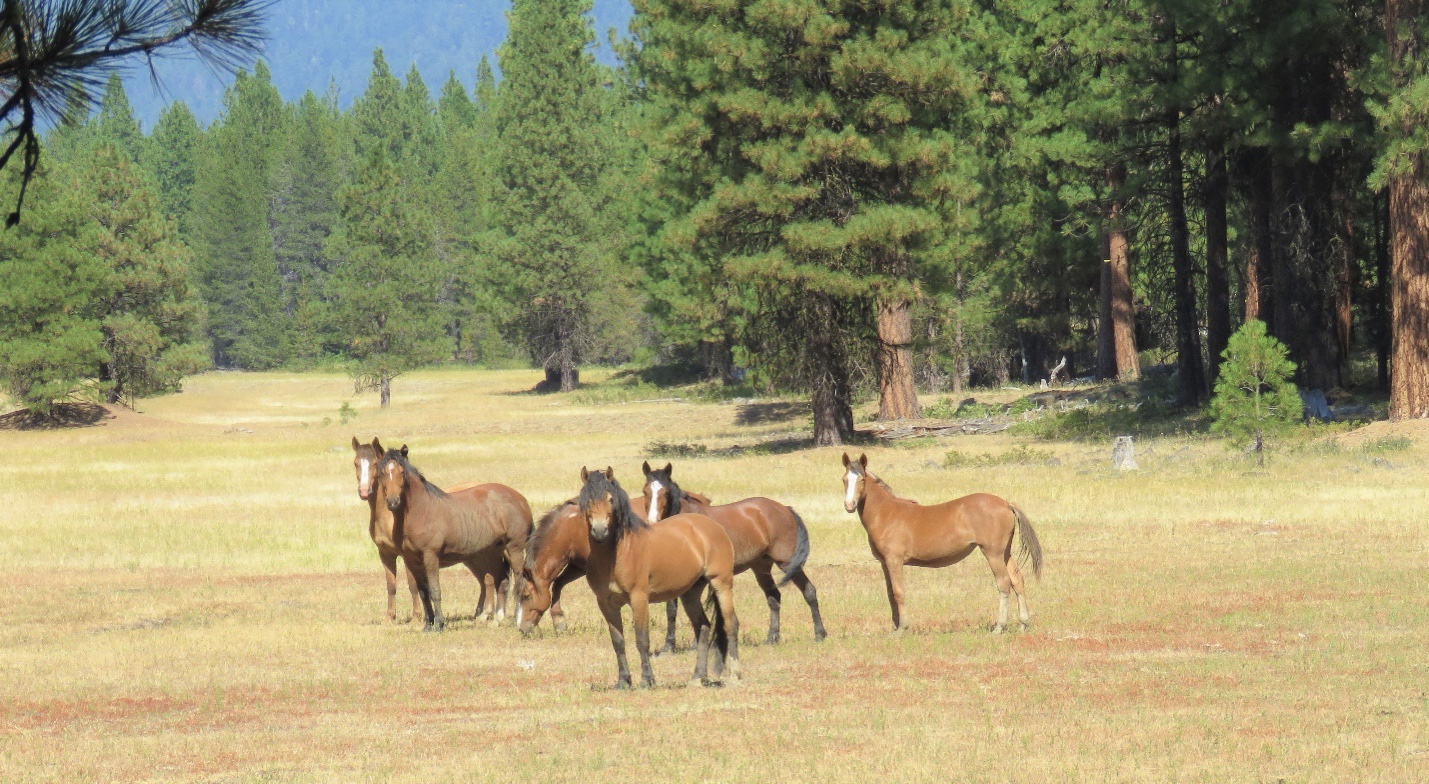
A family band of native wild horses symbiotically grazed-in a fire-break and reduced wildfire fuels, protecting a remote old-growth wilderness forest. Photo courtesy William E. Simpson II
The solution is called the Natural Wildfire Abatement And Forest Protection Plan (aka: Wild Horse Fire Brigade).
The Wild Horse Fire Brigade plan basically works by rewilding currently confined wild horses and humanely relocating wild horses as family bands from areas where they are in conflict with livestock interests, and into economically and ecologically appropriate wilderness areas. In these areas, the wild horses symbiotically reduce critical levels of wildfire fuels and in the process reseed native species flora, which benefits the plants and coevolved fauna that depend on them..
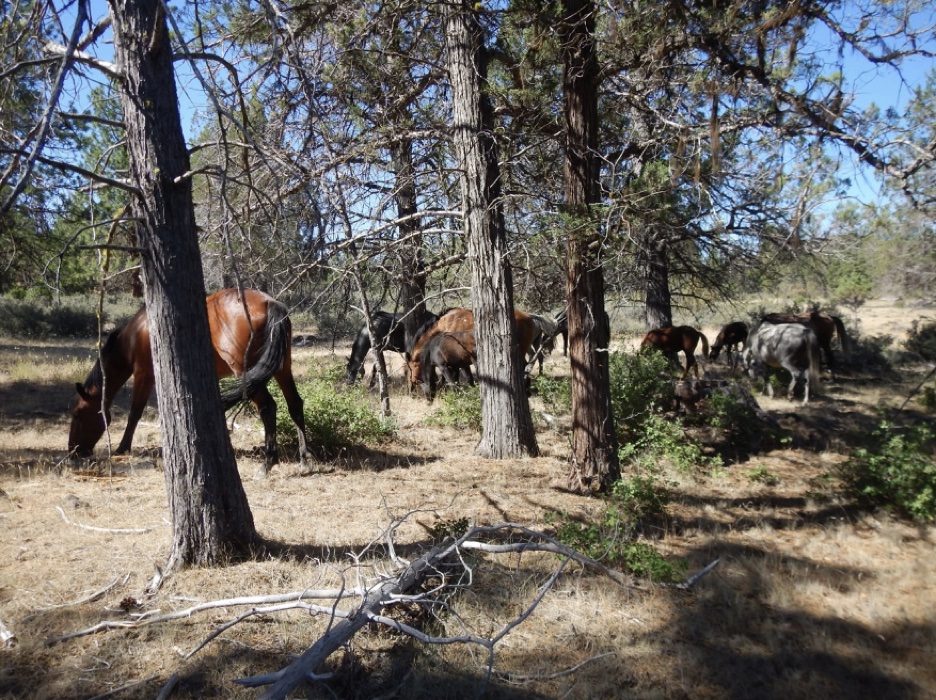
A family of wild horses cleaning wildfire fuels off the floor of a remote wilderness forest. Photo courtesy William E. Simpson II
One adult wild horse eats about 30-35 pounds of dry grass and brush daily. If, for instance, 40,000 horses were released into carefully selected wilderness areas that do not conflict with grazing permits, those areas would have less ground fuel (grasses and brush). The horse herd through grazing could consume and therefore abate 1.2 million pounds of fuels daily.
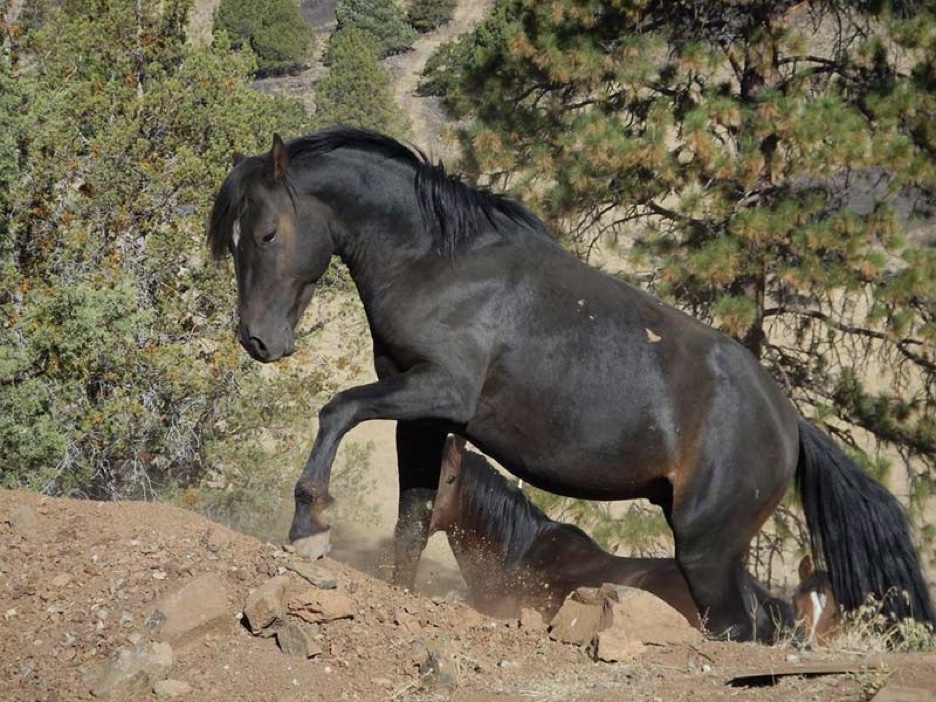
Wild horses can traverse the most rugged terrain and symbiotically reduce wildfire fuels in such areas. Photo: courtesy William E. Simpson II
Less fuel means less fire. >Less fire means less fire suppression and lower related costs. While the essence of the Wild Horse Fire Brigade is described above, it is explained further this article, “Fighting wildfires with wild horses – an untapped equine fire brigade“.
In the Pagosa Daily Press article, I discuss a most interesting connection that I stumbled upon when studying the decline of deer populations in western states in relation to the increase in catastrophic wildfires. The decline of large-bodied herbivores and resulting evolution of catastrophic wildfire is presented in a peer-reviewed published study by Dr. William J. Ripple (et. al.), professor of forestry, Oregon State University, titled, “Collapse of the world’s largest herbivores”:
“By altering the quantity and distribution of fuel supplies, large herbivores can shape the frequency, intensity, and spatial distribution of fires across a landscape”.
The mismanagement of apex predators combined with the prion-based Chronic Wasting Disease (CWD’ is likely involved in California’s plummeting deer population. This thesis and the plan to solve the dilemma aka the Wild Horse Fire Brigade are supported by the Prion Research Center located in Fort Collins, Colorado, in a letter. .,.
And unlike cattle, sheep and cervids including deer, elk and moose, native species American wild horses are conveniently immune to prions transmitting CWD). The disease-causing prions are believed to be transmitted to cervids through contaminated grass and brush. When these prions manifest in cattle, it is called ‘mad-cow’ disease.
As we begin to see, excess grass and brush is the genesis for much more than just catastrophic wildfires.
Could it be that wild horses, which evolved in North America, developed their immunity through an evolutionary process as a part of their mutualism with grasses and other animals? I think this could explain their natural immunity. And since prions are a toxin, it is believed their ability to infect cervids (and potentially cattle) may be dose related.
Did pre-industrial wild horses’ evolutionary mutualisms play a role in limiting excess grasses and brush? That much seems very likely.
If we are being objective and even-handed in our critical observations, the record proves that in addition to being an introduced invasive species, cattle and sheep have over the past two centuries have extensively damaged our American range and forest lands.
Here’s an excerpt from one article on grazing rights by Thomas L. Fleischner, Ph.D.
“The most severe vegetation changes of the last 5,400 years occurred during the past 200 years. The nature and timing of these changes suggest that they were primarily caused by 19th-century open-land sheep and cattle ranching.”
My revelation about mitigating the potential spread of CWD using wild horses and burros benefits America’s $10 billion annual hunting industry. And when combined with the Wild Horse Fire Brigade plan, the savings to the BLM and the insurance industry provides benefits to many stakeholders. The list of benefits is worth repeating….
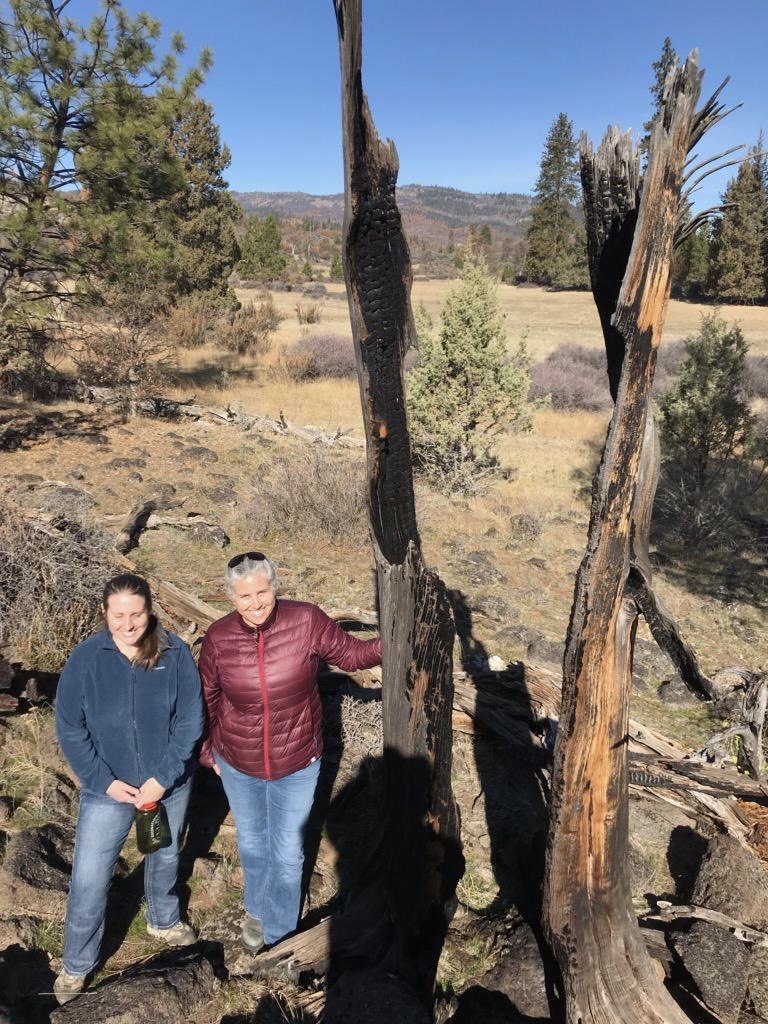
BLM Medford Oregon District Manager Elizabeth Berghard (right) and Lauren Brown (left) manager Cascade Siskiyou National Monument standing by a lightening struck snag that burned furiously, yet the fire didn’t spread to other fuels thanks to fuels reduction by grazing wild horses. Photo courtesy William E. Simpson II
Harnessing the natural abilities of wild horses to once again serve mankind by using them instead of killing them:
1. Releasing the 40,000+ wild horses from BLM corrals into selected wilderness areas that are both economically and ecologically appropriate and where there are no current livestock grazing permits, saves taxpayers about $100 million in annual costs related to roundups and keeping the ~50k horses corralled off-range; and,
2. Mitigating wildfire fuels in remote wilderness areas via Wild Horse Fire Brigade saves the insurance industry hundreds of millions of dollars annually in losses from catastrophic wildfires; and,
3. Less fuel means less fire. Less fire means lower fire-suppression for the USFS, which spends half of its budget on fire suppression., Savings to USFS and BLM-DOI translates to taxpayer savings; and,
4. Grass and brush abatement by wild horses that are immune to prions may alter prion disease vectors and prevent introduction into game animals (deer, elk, moose) that are now succumbing to the prion-caused CWD. , which is great news for the $10 billion (annual) hunting industry.
Having the immune wild horses abate excess grasses and brush may also may provide some fire-walling against transmission of emerging prion diseases into domestic livestock herds from deer and elk, which may in turn potentially inhibit prions from infecting humans. Releasing wild horses back into the wilderness and creating a pilot program to study their effect on CWD may also lead to some insights and methodologies for protecting livestock and cervids long-term; and,
5. Last but not least, wild horses & burros provide highly beneficial symbiotic mutualisms to all of their historical ecosystems. Plus, they add to the aesthetics and tradition of the American wilderness, which is consistent with the Congressional preamble to the 1971 Wild Burro and Horse Protection Act.
Conclusion
The current American wild horse management paradigm fails economically and ecologically. Despite decades of activity, the wild horse advocacy has had virtually no meaningful effect on the plight of American wild horses. And, unfortunately, they have offered no plan that is genetically, ecologically or economically sustainable that allows wild horses to truly be “wild and free” as is intended by the 1971 Free Roaming Wild Burro And Horse Protection Act.
The Wild Horse Fire Brigade can provide a naturally sustainable, cost-effective solution that benefits a majority of all the stakeholders as well as the wild horses (and burros) and the wilderness ecosystems that can be assigned to them.
About the author:
William E. Simpson II is a naturalist/rancher living among and studying native species American wild horses. He is recognized expert on wild horses and their management by numerous county and federal officials. Mr. Simpson is the author of two published books and more than 100 published articles on subjects related to wild horses, wildlife, wildfire, and public land (forest) management. He has appeared on NBC NEWS, ABC NEWS, the DoveTV and has been a guest on numerous talk radio shows including the Lars Larson Show, the Bill Meyer Show, and on NPR Jefferson Public Radio.
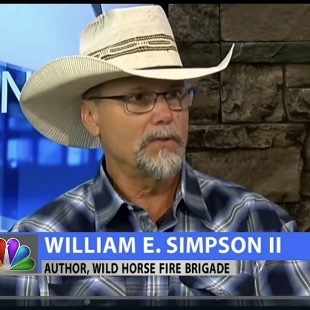
#WildHorses #BLM #USFS #Rewilding #PublicLands #WHFB #Wildfire
—————————————–

